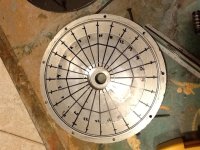John in CR said:
icecube57 said:
Would scoops like this help force air into the hub.
No. Jeremy did a calculation in the other thread.
I checked Jeremy Harris's calculation. He got it right: At 30 mph, a scoop 4'' from the axle on a 26'' wheel would generate a pressure of 0.027 psi when facing forward. He concluded that scoops aren't worth the effort because this is such a small pressure difference. However, he didn't actually calculate the pressure difference achievable with a hub turned into a centrifugal fan. I did that, and found it to be even lower!
Here's the scoop (pun intended):
For the scoop, the pressure difference is 1/2 * rho * v^2, where rho is the density of the air, and v is the velocity of the scoop with respect to the outside air rushing by (taken as the velocity of the scoop w/r to ground). For the centrifugal fan, take a cylinder spinning at angular velocity omega. Assuming, for the present purpose, that air is incompressible (since the pressure differences are so small), the pressure inside the cylinder is P0 + 1/2 * rho * (omega * r)^2 where P0 is the pressure at the axle, omega is the angular velocity, and r is the distance from the axle. In other words, the pressure difference is also given by 1/2 * rho * v^2, except here the velocity is the velocity of the exit hole with respect to the axle (assuming the intake hole is right at the axle).
The ratio of the two pressures, for a 26'' wheel (radius 13'') and an intake scoop (or exit hole for the centrifugal fan) 4'' from the axle is thus p_scoop / p_cent_fan = (1 + 13/4)^2 ~= 18. This only depends on where on the hub the hole is, not on the speed, which cancels out. Since the air flow rate through a hole is proportional to the square root of the pressure difference, the scoop concept will produce an air flow that is (1+ 13/4) = 4.25 times greater than the centrifugal fan concept. In other words, scoops cool roughly 4 times more efficiently than centrifugal fan blades, for the same size holes!
(We might want to divide this number by 2 since only about half the scoops are facing forward at any given time. However, the centrifugal fan efficiency is also less than calculated since (i) the intake holes are at some distance from the axle, and (ii) the stationary stator inside the hub prevents the air from spinning at the same rate as the wheel. So advantage: scoop!)
In the scoop design, the intake holes are covered with scoops and should be as far from the axle as possible. Separate exit holes are not needed since the scoops, when they face backwards at the bottom of the orbit, serve as exit holes. However, in order to get air from one side of the motor to the other, it might make sense to drill a set of exit holes on the other side (w/o scoops).
I am working on implementing this on my hs3540. 6 scoops will go under the brake rotor, forcing air into 1.25'' holes. Will post pictures and temperature measurements as they become available.


